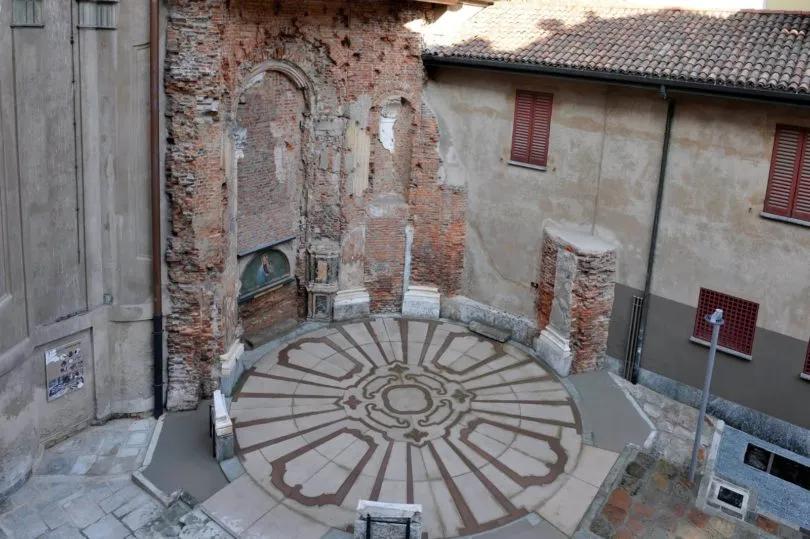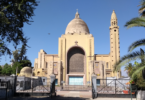
Introduction
The Gothic beauty of the Church of Santa Maria Alla Porta resonates in the city of Milan. Santa Maria Alla Porta is officially known as Chiesa di Santa Maria Alla Porta. Although a church already stood in the same Milanese location since before the year 1105, the present church was erected in 1652 under Spanish rule. This church dates back to 17th Century when it was constructed.
Francesco Castelli, the original Mendrisiotto architect and engineer (not to be confused with Francesco Castelli, colloquially known as “il Borromini”), finished the project after architect Francesco Maria Richini passed away in 1658. Castelli was also in charge of building the Baroque gate and the tall tympanum. The church’s toponym, “alla porta” (at the gate), comes from its construction where the former Porta Vercellina once stood as a portion of the wall that Augustus built during the Republican era. The avenue that faces the chapel, via Santa
This beautiful church was designed by renowned Italian architect, Francesco Maria Richini and boasts of Baroque architectural elements. The interiors of this church feature artifact collected from over the centuries.

According to a historical testimony by Landolfo Luniore (1077-1137), known as Landolfo di San Paolo, in his Historia Mediolanensis [History of Milan], it seems that the church of Sancta Maria ad Portam already existed before the 12th century in the same place where it stands today. Santa Maria Alla Porta is also referred as Chiesa di Santa Maria alla Porta. It would have served as a minor church, though, since it was neither a Decuman church nor the place of litanies. Landolfo in the same work reported that on May 7, 1105, during the demolition of the pre-existing church, precious relics were discovered, among which were a part of Jesus’ burial clothes and his Holy Shroud, a piece of the stone on which the angel who announced the resurrection was seated, a splinter of the Holy Cross, and a fragment of Mary’s dress.
Existed before the year 1105, the current church of Chiesa di Santa Maria alla Porta It was erected in Milan during the Spanish domination in the year 1652 by the architect Francesco Maria Richini. When he died in 1658, the work was completed by Francesco Castelli known as Borromini, to whom he owes the construction of the baroque portal and the covering of the tympanums. The church has the toponymic suffix “at the gate”, because it was built on the site where the ancient Vercellina Porta part of the wall erected by the Republican era Augusto; The street on which the church is located, via Santa Maria alla Porta, was part of the decumano that Piazza San Sepulchre leads to the port of Vercellina.
Among the most significant historical events associated with the church is the celebration of the wedding of the Duke and Duchess of Milan, which took place here in 1561. On December 8, 1651, when an external wall was being demolished as part of the reconstruction of the old church using Richini’s design, they discovered a fresco depicting the Virgin Mary with the baby Jesus on her lap, called the Madonna del grembiule [the Virgin of the Apron]. The discovery created an influx of donations from parishioners to ensure the renovation of the church. The result was its single nave architectural plan from 1652.
Little would be known about the appearance of the church before Richini’s reconstruction if it were not for its description, including the building plan, which can be found in documents of Federico Borromeo’s pastoral visit in 1605. During the plague years of 1630, the church served as a hospital for the sick. In addition, the church played an important role during times of war, when it was used as a refuge for citizens fleeing battles.
Restoration process of the complex over the years, the church has undergone numerous restoration interventions aimed at preserving its beauty and historical value. Among the recent renovation works, the one carried out in 1996 stands out, which brought to light internal frescoes and decorations. The complex of Santa Maria Alla Porta is surrounded by numerous legends, including that of the ghost of the monk who is said to still wander today in search of his ancient rooms.

On the night between 12 and 13 August 1943, the church, sharing the fate of many other churches in Milan, was hit hard by the Anglo-American air raids of World War II. The church building to the left and the group of buildings to the right of the temple (the area which is now a palace Luigi Caccia Dominioni 1961), wreaking havoc the chapel, its 17th century furniture and the 16th century fresco of the “Madonna del apron” which was located inside. Still visible on the facade are the pink granite columns, chipped and holes caused by shrapnel from bomb shells; the high relief of Simonetta is heavily damaged and mutilated in some protruding parts.
Of the old chapel remain today only a few scattered ruins on the right of the church to certify its ancient presence, with a restoration lasting three years and ending in November 2015. With the redevelopment works along the The Santa Maria alla Porta alley also found the old marble floor which it was decided to keep again due to lack of financial means necessary for its redevelopment and the fresco was discovered Madonna’s Apron or Our Lady of the Miracles, previously protected by a wooden box and now restored and returned to the devotion of the faithful. However incision Marcantonio Dal Re (1697-1766) and some rare photographs clearly show the structure then destroyed
They also lost the two 19th century statues of angels placed on the platforms of the ear drum and the two statues placed in the two second-order niches and which are visible in some photos from the beginning of the 20th century. Santa Maria alla Porta is a chaplaincy for the faithful of the Polish language as evidenced by a plaque placed next to the entrance.
Architecture of Chiesa di Santa Maria Alla Porta

The three-sided tympanum by Borromini that embellishes the wonderful ornate exterior, shifting back and forth between the Corinthian and Ionian Orders of segments, safeguards the dazzling high-help via Carlo Simonetta, worked in 1670 and portraying the Suspicion of Mary (committed as Mariae Assumptae). Under the tympanum, the Request is upheld by a huge rock platform, with the engraving, ascendit semi aurora consurgens.
On the sides, the specialties are involved by two models of figures, finished by Giacomo Moraglia (1791-1860). Scarcely noticeable from the road is a little vault that covers the congregation, maybe made by Girolamo Quadrio and that hosts, in the cut out specialties, four sculptures of heavenly messengers by Giuseppe Vismara and Simonetta, etched in 1662.
The single nave isn’t exceptionally wide and has four side sanctuaries decorated with white marble sculptures; the special stepped area of Magdalene is adorned by Stefano Sampietro in the sacristy is the work by Camillo Procaccini (seldom noticeable in view of the rare openings of the congregation).
The church is described as having three aisles/naves and a shape of a cross, and facing the east. In total, it was around 65 feet long and 26 feet wide, decorated with frescoes by Luini and Bramante. The facade was finally restored in 1856, after the completion of the restoration of the building, the floors with the burial sites underneath, and the surrounding spaces that parish priest, Alberto De Capitani d’Arzago had started in 1854.
A plaque against the right wall of the church lists the priests of Santa Maria alla Porta. The first on the list is Marco Azzoni, active around 1450, but actually, Maffeo Monza, an active priest from 1536 to 1574, was the first priest with confirmed dates of activity.
Relics
Reported that on May 7 1105, during the demolition of the pre-existing church, precious relics were discovered, among which were a part of Jesus’ burial clothes and his Holy Shroud, a piece of the stone on which the angel who announced the resurrection was seated, a splinter of the Holy Cross, and a fragment of Mary’s dress. Another historian named Torre mentions the same relics in 1674, and also records the presence of the venerated bones of sub-deacons, Saints Casto and Polimio.
Artwork of Santa Maria Alla Porta
Santa Maria Alla Porta is one of the Gothic treasures of Milan, and its decorative beauty is one of its most fascinating elements. The external decorative elements of the building include the rose window on the side of the facade and numerous medieval statues. But it is inside the church that one can truly appreciate the artistic decoration of the structure.
The walls and domes have been painted with vibrant frescoes depicting scenes from the lives of St. John the Baptist, Jesus, and Mary. Medieval painters embellished the interior of the church with golden leaves on a black background, creating an effect of extreme relief.
The most iconic moment of the visit to Santa Maria Alla Porta is undoubtedly the view of the main nave, dominated by the magnificent dome crowned with a ring of golden statues. The frescoed interior decorations and marble altars further enhance the interior of the building, conveying an incredible sense of sacredness and mystery.
Restoration of Santa Maria Alla Porta
Restoration and conservation the beauty of Santa Maria Alla Porta has been preserved over the centuries thanks to restoration and conservation work carried out by the Historical Archive. The restoration process of the complex required patient and careful work, which included the analysis of original materials and the selection of quality products for the restoration. The challenges in conserving the building were numerous, especially due to atmospheric pollution and the passage of time.
The use of advanced techniques in cleaning the exterior façade and internal frescoes has allowed the original beauty of this Gothic masterpiece to be brought to light. Despite the difficulties encountered, the conservation efforts have been rewarded and today Santa Maria Alla Porta stands majestic, as a testimony of the skill and passion of the architects who built it and the restorers who brought it back to its original splendor.
Miracles
It is said that in the church of Santa Maria Alla Porta there is a fresco depicting the Virgin Mary, which miraculously survived a fire that broke out inside. It is even said that the work is able to emit its own light, to the benefit of night visitors. Another legend hovers around the cloister of the church, which would have been frequented by mysterious and dark figures, such as witches and evil spirits.
Feast celebrated at Santa Maria Alla Porta
The miraculous finding of various relics during the renovation phases gave origin to the “Festa Del Salvatore” [Feast of the Saviour], which was celebrated every 9 May with a procession that went from the church of Saint Tecla to Santa Maria alla Porta. The parishioners would wave fresh fronds and carry candles while reciting aloud the word agios (holy, pure), which was the original name of the popular Festa dell’agios (Feast of the Holy/Pure).
Annual Feast Day
Annual Feast Day – 4th November.
The annual feast day of Santa Maria Alla Porta is celebrated on 4th of November every year.
Mass Timing
Weekdays
- Monday: 08.30 am, 11.00 am (in Italian & polish)
- Wednesday: 08.30 am, 11.00 am (in Italian & polish)
- Friday: 08.30 am, 11.00 am (in Italian & polish)
Weekend days
- Sunday: 8:30 am, 11:00 am (in Italian & polish)
- Saturday: 08.30 am, 11.00 am (in Italian & polish)
Contact Info
10, 20123 Milano MI, Italy
Accommodations
How to reach the Sanctuary
Airways
The nearest Airport to the church of Santa Maria Alla Porta is Milan Malpensa Airport which is just 49 kilometres away from the church.
Railways
The nearest Railway to the church of Santa Maria Alla Porta is Meravigli station which is just 1.5 kilometres away from the church.








